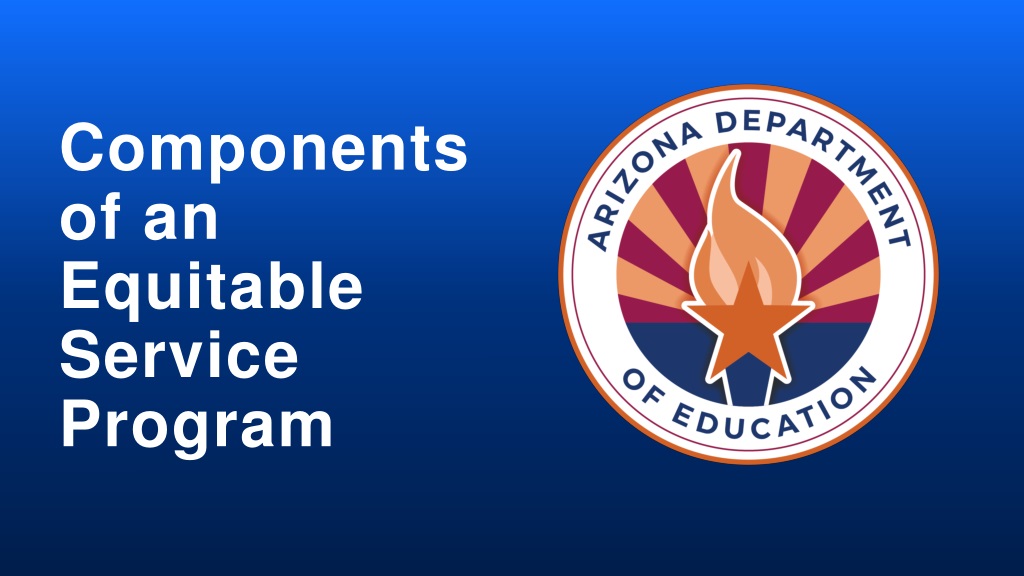

0 likes | 17 Views
This program governs equitable services for various education programs under ESEA Title I, Part A and Title VIII, ensuring consultation, timely notices, and meaningful participation for private schools. The program covers Title I, Part C, Title II, Part A, Title III, Part A, Title IV, Part A, Title IV, Part B, and Title IV, Part F. Private schools must meet specific criteria for participation and receive equitable shares of funding based on eligibility. Consultation processes, eligibility criteria, and funding allocations are key components of ensuring equitable services are provided.

E N D
Components of an Equitable Service Program
Applicable Programs Session Objectives Ongoing Consultation Program Evaluation
Programs Title I, Part A equitable services governed under ESEA section 1117 and 8501 ESEA, Title VIII equitable services provisions cover the following programs: Title I, Part C - Education of Migratory Children Title II, Part A - Supporting Effective Instruction Title III, Part A - English Language Acquisition, Language Enhancement, & Academic Achievement Title IV, Part A - Student Support and Academic Enrichment Title IV, Part B - 21st Century Community Learning Centers Title IV, Part F - Project School Emergency Response to Violence (Project Serve)
Timely & Meaningful Consultation Timely - all parties must have adequate notice or “time” to ensure they are prepared to make informed decisions Meaningful - all parties must have the opportunity to share visions and consider all viewpoints in the process ESEA sections 1117(b)(3) and 8501(c)(3)
Notice of Intent to Participate • Send to all potential participating private schools • Importance of deadlines • Private schools’ data = program participation eligibility • Slight modifications for FY25 https://www.azed.gov/titlei/privateschools
Private School Equitable Share • Title I-A • Students who live in a Title I funded school boundary AND qualify based on income • Title I-C (MEP Bootcamp February 7th, 2024) • LOA (SEA or LEA) serving the geographical location • Eligible students (1) meet the statutory and regulatory definitions of a migratory child and (2) the State has properly recorded its determination that the child is a “migratory child” on the national Certificate of Eligibility (COE) • Title II-A • Private school must be located withing the LEA’s boundary • Total enrollment • Title III-A • Private school must be located withing the LEA’s boundary • Number of eligible EL students on October 1 • Title IV-A • Private school must be located withing the LEA’s boundary • Total enrollment • Title IV-B • Grantee serving geographical location • Equitable services OR equal expenditure
Title III-A I-4. Must an LEA use the standardized, statewide entrance and exit procedures that it uses in public schools to identify and exit ELs in private schools? • No. Under ESEA section 3113(b)(2), each SEA is required to establish standardized, statewide entrance and exit procedures that must be implemented in each LEA in the State. Unlike with public school students, unless required by State law, there is no requirement that private school students be identified as ELs or exited using those entrance and exit procedures. However, the LEA may use the standardized statewide entrance and exit procedures if, after timely and meaningful consultation with private school officials, it is determined to be an appropriate method for identifying and exiting eligible students in a private school. I-5. What are some examples of how an LEA might identify children who are eligible for Title III, Part A services in private schools that choose to participate in Title III, Part A equitable services? • In consultation with private school officials, an LEA should establish objective criteria to determine which private school children are eligible for Title III, Part A services. For example, an LEA and private school officials may decide to identify ELs based on: (1) responses to a primary or home language other than English (PHLOTE) survey and (2) scores on an English language proficiency (ELP) screener assessment or using the same process utilized in the statewide entrance procedures (see I-4).
Affirmation of Consultation • Only private nonprofit schools with verifiable data • Deadline – Due September 30th • Transferring funds • Preliminary yearlong planning https://www.azed.gov/titlei/privateschools
Programs • Equitable ≠ Equal • Title I-A ≠ Materials only • Title II-A – Professional development • Title III-A ≠ AZELLA costs • Title IV-A – 20/20 Rule with 15% special rule for technology infrastructure • Administrative Costs – Title I-A 10%, Title III-A 2%, Title IV-A 2% • Indirect Costs – Approved indirect cost rate x total equitable share; LEA IC + PNP IC = max indirect cost
Supplement Not Supplant • Supplanting should be the presumption for equitable service activities • An LEA must use funds to meet the identified needs of eligible private school participants and not the needs of the private school or the general needs of children in the private school • An LEA must also ensure that the equitable services do not replace the education for participating students that the private school provides all students
Ongoing Consultation Private School Timeline Resource https://www.azed.gov/titlei/privateschools • Budget reconciliation • Data collection • Revisions/adapting program • Revolving participant eligibility data
Program Evaluation/Carryover • Funds allocated to an LEA for educational services and other benefits to eligible private school participants must be obligated in the fiscal year for which the funds are received by the LEA. ESEA sections 1117(a)(4)(B) and 8501(a)(4)(B) • Program evaluation
Contact Information Tiffiany Morse 602.542.7466 tiffiany.morse@azed.gov privateschoolsombud@azed.gov EANS/Equitable Service Program Specialists Nikole Fletcher Sara Shaffer https://www.azed.gov/titlei/privateschools https://www2.ed.gov/about/inits/ed/non-public-education/index.html